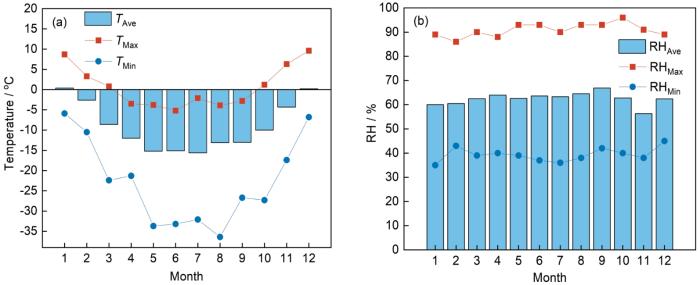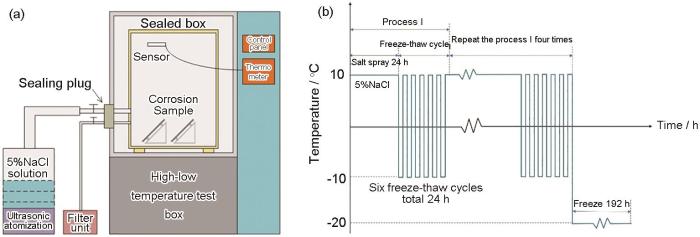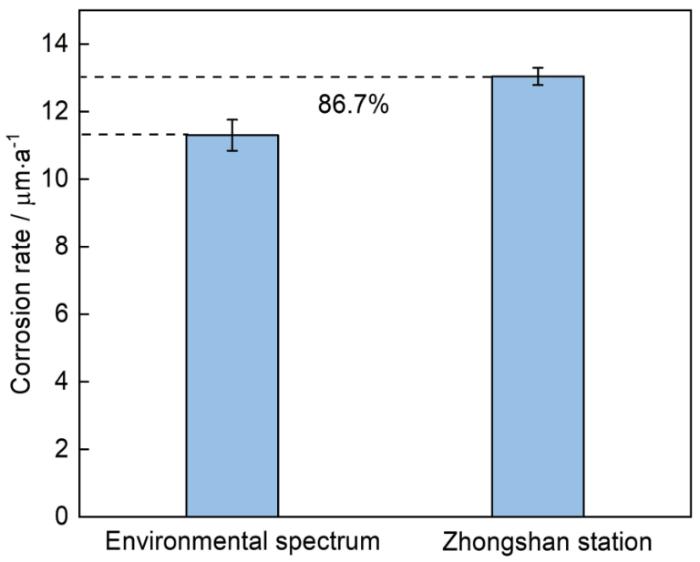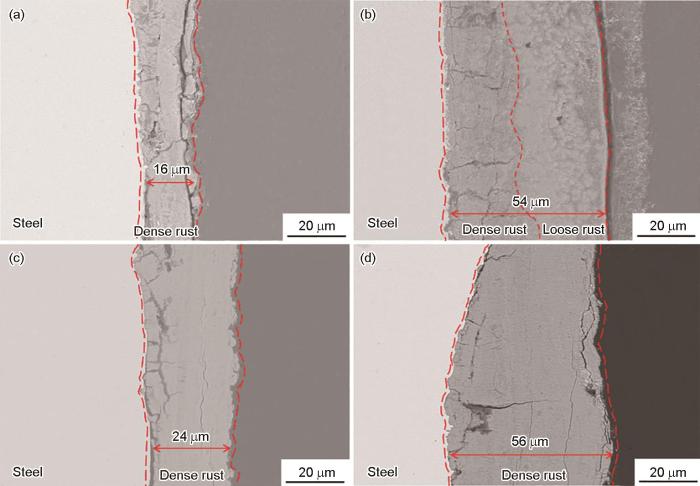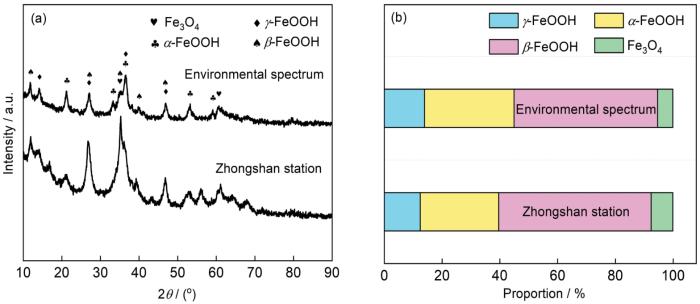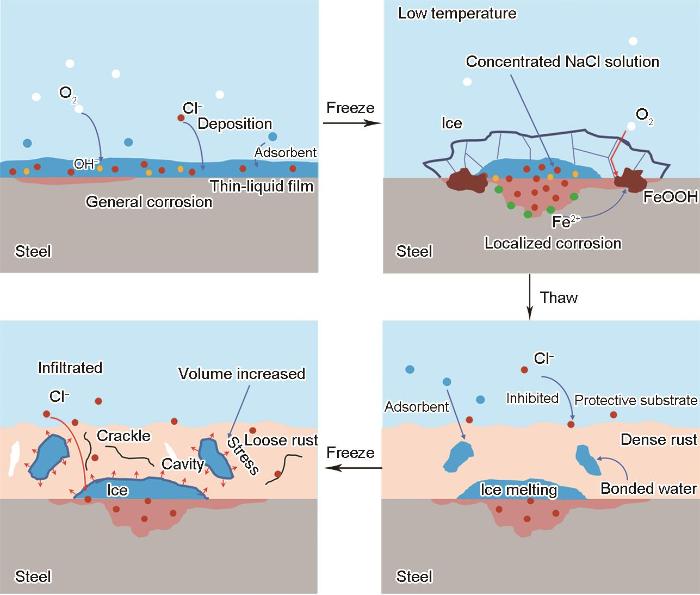极地区域具有丰富的经济价值及军事价值,在当下国际形势中其权益维护愈发重要,我国“中俄元首项目”、“冰上丝绸之路”等外交合作,以及我国海军“近海防御、远海防卫;大洋存在、两极拓展”的战略转型,都凸显了极地的重要性。欧美等靠近极圈国家在极地区域早期开展了系列材料腐蚀研究工作,其中MICAT项目[1]南极站点Fe、Cu、Zn和Al典型金属材料1年最高腐蚀速率分别为55.2、2.75、2.43和5.47 μm/a。Rosales和Fernandez[2]在南极Jubany站研究表明在海盐存在的情况下,冰层下的金属表面可能会形成液态水层,导致温度低于0℃时腐蚀发生。上述研究表明,金属在北极和南极地区的腐蚀损伤问题不容忽视。
Maxwell和Viduka[3]通过研究南极Ross岛上金属材料及涂层等有机材料的腐蚀老化行为,认为影响极地区域腐蚀的主要环境诱因包括:(1) 风速:南极地区风速较高,且风沙、冰粒等会导致材料表面破坏;(2) 紫外:南极强紫外作用加速有机材料老化失效;(3) 盐沉积:材料表面覆盖的冰雪中含有大量沉积盐,此外大气气溶胶不容忽略;(4) 温-湿度:夏季冰雪融化导致材料表面形成液膜,且湿度变化大。屈少鹏等[4]针对极地腐蚀环境进行分析,将极地大气区腐蚀特征归纳为:薄液膜腐蚀、局部腐蚀、干湿交替以及冲刷腐蚀。崔中雨等[5]研究表明南极低温冰雪覆盖环境下腐蚀过程仍能发生,夏季温度升高金属表面冰雪存在凝-融过程导致液膜长时间存在且加速了局部腐蚀。
Ni-Cr-Mo-V低合金高强钢是舰船制造常用钢种,其在极地环境下的腐蚀行为还处于未知。本文通过Ni-Cr-Mo-V低合金高强钢在实验室加速试验谱环境与中山站极地大气环境下腐蚀行为的对比研究,验证加速试验环境谱的合理性,讨论极地低温大气环境下低合金钢的腐蚀机理,为高强钢在极地低温地区的腐蚀评价提供参考依据。
1 实验方法
本实验所用材料为添加Ni、Cr、Mo和V等耐蚀元素的低合金高强钢,主要合金元素(质量分数,%)为:C 0.052,Mn 0.892,Ni 7.27,Cr 0.587,Mo 0.636,V 0.066,其余为Fe。实验室内加速腐蚀采用40 mm × 30 mm × 2 mm尺寸试样,南极中山站户外暴露腐蚀试样尺寸为150 mm × 75 mm × 2 mm,试样前处理方式一致,均用1500#砂纸将表面打磨光亮并保持划痕方向一致。
户外暴晒腐蚀试验在南极中山站大气试验场,试验时间为2019年1月~2020年1月,样品与水平面成45°倾斜固定于试样架。南极中山站位于69°22'24.76"S,76°22'14.28"E,根据所统计2019~2021中山站平均大气数据(图1)显示,中山站夏季最高温度达9.6℃,冬季最低温度-36.4℃,年均温度高于-15℃,年均相对湿度60%。
图1
图1
2019-2021年中山站大气环境
Fig.1
Environmental parameters of Zhongshan station during 2019 to 2021: (a) annual average temperature data, (b) annual average humidity data
根据中山站大气环境数据建立实验室内加速腐蚀试验环境谱,在前期对极地户外试样研究过程中发现,金属试样表面三维轮廓图中,未见明显由风沙导致的划痕缺陷。同时极地强紫外辐照主要影响涂层材料的老化失效,因此以低温盐雾、冻融循环及低温冰冻方式完成低合金钢中山站大气腐蚀1 a的仿真过程。实验通过自行搭建的极地室内模拟加速环境试验箱进行,加速腐蚀环境谱详细参数见图2。过程一包括:(1) 以南极中山站夏季最高温度10℃作为盐雾试验环境温度,盐雾通过外置超声加湿器通入试验箱内,喷雾量1~2 mL /80 cm2·h,每次盐雾时间为24 h;(2) 在度夏期间冰雪凝-融过程导致金属表面长期存在液膜,选用-10/10℃作为加速冻融试验条件,每温度各2 h交替变化,持续24 h。重复过程一4次后,将试验试样在-20℃冰冻保存8 d以模拟中山站冬季低温环境。室内加速试验谱的建立过程参照前期研究[8]。
图2
图2
极地室内模拟加速环境试验箱及环境谱周期示意图
Fig.2
Schematic diagram of indoor simulation and acceleration environment test device (a) and environmental spectrum period (b)
采用500 mL HCl + 3.5 g六次甲基四胺 + 500 mL H2O配制成的除锈液对加速试验1周期后的试样以及南极中山站暴露1 a的试样进行除锈处理,并按
其中,v1表示单位面积腐蚀速率(g·m-2·a-1),v表示腐蚀速率(μm·a-1),ω0表示试样原始质量(g),ω1表示除锈后试样质量(g),S表示试样腐蚀面积(m2),ρ表示低合金钢密度(约为7.86 g/cm3),t表示腐蚀时间(a)。
此外,分别使用Gemini SEM 300扫描电子显微镜(SEM)及D8 advance X射线衍射仪(XRD)分析两种试验环境下Ni-Cr-Mo-V钢腐蚀产物形貌和组成,并使用Jade软件对腐蚀产物组成进行半定量分析,以确定腐蚀产物各相含量。利用KEYENCE激光共聚焦显微镜观察表面腐蚀形貌并分析点蚀情况。
2 结果与讨论
2.1 腐蚀速率分析
图3为Ni-Cr-Mo-V钢室内加速试验环境谱加速腐蚀1周期以及南极中山站暴露1 a后的腐蚀速率。可以看出,Ni-Cr-Mo-V钢加速腐蚀1个周期后,腐蚀速率约为11.30 μm/a,室外自然环境暴露1 a后的腐蚀速率为13.04 μm/a,二者比值为86.7%。环境谱腐蚀速率与中山站实际投样腐蚀速率相近,这表明低合金钢在室内环境谱和中山站大气暴露的腐蚀行为相近,所设计的极地加速环境谱可较好地代替户外投样以完成金属的耐腐蚀评价。
图3
图3
Ni-Cr-Mo-V钢室内加速试验谱腐蚀1周期与中山站大气腐蚀1 a腐蚀速率对比
Fig.3
Comparison of corrosion rates of Ni-Cr-Mo-V Steel: (a) one period of indoor accelerated corrosion test, (b) outdoor at Zhongshan station in Antarctica for 1 a
表1为钢铁材料在不同大气环境下的腐蚀速率对比[9,10],气候环境从热带至极地低温海洋环境,钢铁材料的腐蚀速率随大气温度的降低呈现下降趋势。中山站常年处于低温环境,室外暴露试样长期处于冰雪覆盖状态,钢铁材料的腐蚀速率与温带海洋环境(青岛)下腐蚀速率并未有明显的降低(Q235钢:青岛,18.73 μm/a; 中山站,16.3 μm/a),表明在低温环境下,表面液膜成为影响腐蚀速率的主要因素。在温带至热带海洋大气环境下,低合金钢的腐蚀速率均低于普通碳钢,其归因于各类合金元素的添加改善了锈层对基体的保护性。暴露于中山站大气环境的Ni-Cr-Mo-V钢腐蚀速率低于Q235钢,表明合金元素在低温下仍能促进保护性锈层的生成。
表1 钢铁材料在不同大气环境下的腐蚀速率
Table 1
| Material | Exposed position | Climatic | Time / a | Corrosion rate / μm·a-1 |
|---|---|---|---|---|
| Q235 | Zhongshan station | Polar marine atmosphere | 1 | 16.3 |
| Q460 | Zhongshan station | 1 | 10.8 | |
| Q960 | Zhongshan station | 1 | 15.8 | |
| Ni-Cr-Mo-V | Zhongshan station | 1 | 13.0 | |
| Q235 | Qingdao | Temperate marine atmosphere | 1 | 18.7 |
| Q460 | Qingdao | 1 | 17.0 | |
| Q960 | Qingdao | 1 | 17.3 | |
| Q235 | Guangzhou | Subtropical marine atmosphere[9] | 1 | 32.6 |
| Q345 | Guangzhou | 1 | 30.9 | |
| Q235 | Wanning | 1 | 63.6 | |
| Q345 | Wanning | 1 | 58.8 | |
| Q235 | Maldives | Tropical marine atmosphere[10] | 1 | 119.0 |
| WS | Maldives | 1 | 74.0 | |
| 3Ni WS | Maldives | 1 | 49.0 |
2.2 腐蚀产物形貌分析
图4
图4
不同环境下Ni-Cr-Mo-V钢腐蚀产物的表面形貌
Fig.4
Surface morphologies of corrosion products of Ni-Cr-Mo-V steel under accelerated corrosion environment spectrum (a, b) and atmospheric corrosion of Zhongshan station (c, d)
Ni-Cr-Mo-V钢在加速腐蚀1周期及南极中山站暴露1 a后的锈层截面形貌见图5。Ni-Cr-Mo-V钢在两种腐蚀环境下生成的锈层厚度均存在较大差异(10~60 μm不等),且锈层内存在较多裂纹缺陷。室内加速腐蚀后锈层存在明显的分层现象,南极大气环境下Ni-Cr-Mo-V钢锈层更为致密且无分层现象,锈层平均厚度与室内模拟环境下锈层厚度相近。在室内模拟过程中由于盐雾作用使得试样表面形成水膜,形成外部疏松、呈浮锈状锈层,因此在锈层截面形貌上存在一定差异。在南极度夏过程中,昼夜温差变化带来的热胀冷缩使得锈层与基体结合界面产生应力,导致了内部裂纹的产生,使得锈层保护性劣化。裂纹、空腔的存在使Cl-不断渗入基体材料,疏松的铁锈层有利于Cl-的富集,导致基体与锈层结合界面的局部酸化,进一步加速腐蚀。
图5
图5
不同环境下Ni-Cr-Mo-V钢腐蚀产物的截面形貌
Fig.5
Section morphologies of corrosion products of Ni-Cr-Mo-V steel under accelerated corrosion environment spectrum (a, b) and atmospheric corrosion of Zhongshan station (c, d)
图6是Ni-Cr-Mo-V钢室内加速试验环境谱腐蚀1周期及南极中山站暴露1 a后的表面腐蚀形貌。Ni-Cr-Mo-V钢在两种环境中均倾向于均匀腐蚀,局部位置伴随点蚀坑出现。环境谱腐蚀中大部分点蚀坑深度、体积均较小,只有少数点蚀坑深度超过20 μm,而中山站大气腐蚀中最大点蚀深度超过80 μm,要明显大于室内模拟,平均点蚀深度为21.13 μm。实验室环境下,长周期的腐蚀在几天内完成,锈层生长迅速,在短时间内对基体形成了保护作用。由于盐雾的作用,大量的水汽在短时间内沉降在金属表面并形成厚液膜,同时过量的盐随液膜从表面流失,使得基体表面盐沉积量减少,减缓了点蚀过程。而在南极环境下,海盐通过干/湿沉积的方式沉降在试样表面,且南极环境下降水以降雪方式完成,无法冲刷掉表面沉积盐,在冰雪覆盖下形成高浓度的电解质环境,加深了局部腐蚀。
图6
图6
不同环境下Ni-Cr-Mo-V钢的表面腐蚀形貌
Fig.6
Surface corrosion morphology of Ni-Cr-Mo-V steel under accelerated corrosion environment spectrum (a, b) and atmospheric corrosion of Zhongshan station (c, d)
2.3 腐蚀产物成分分析
图7
图7
室内模拟及南极大气环境下Ni-Cr-Mo-V钢腐蚀产物XRD及物相组成的半定量分析结果
Fig.7
XRD (a) and the semi-quantitative analysis (b) of corrosion products formed on Ni-Cr-Mo-V steel under indoor simulation and Antarctic atmospheric environment
南极大气的盐沉积过程与温度、湿度和风速均存在一定的关系,海盐气溶胶可根据气象条件通过湿沉积或干沉积从大气中完成沉积过程[16],大多数海盐气溶胶可以通过降雪的方式完成沉积过程,因此冰雪融化后,盐粒沉积在金属表面,形成电解质环境。中山站夏季气温处于0℃,电解质层能够以液膜形式存在,且年均湿度处于50%~60%,由于中山站临近普里兹湾,大气中充满海洋气溶胶。中山站大气环境满足生成β-FeOOH高湿高盐的环境特征[17]。Huang等[16]统计了中山站表层雪中离子含量,Cl-含量约为1600 μg·L-1。Xu等[18]采集中山站附近气溶胶样品,Cl-平均含量约1000 ng·m-3,最高含量大于3000 ng·m-3。在南极大气盐沉积过程中,降水多以降雪的形式,海洋气溶胶随降雪沉降在金属表面,由于缺少雨水的冲刷使得沉积在试样表面的盐分难以去除,从而处于较高的盐含量环境,促进了β-FeOOH的形成。
2.4 极地低温大气腐蚀机理
在极地海洋大气环境下,由于腐蚀电解质状态不同,金属的大气腐蚀过程及机理同样有别于常温海洋大气环境。图8为低温及冰雪凝-融环境下的腐蚀机理示意图。当海洋气溶胶通过干/湿沉积的方式沉降在金属表面时,金属表面形成电解质环境。由于盐分的存在,表面液膜通常可以在冰点温度以下存在,此阶段与常温海洋大气环境腐蚀行为相似,倾向于均匀腐蚀过程,由于低温环境影响离子传导速率,因此腐蚀过程主要受温度控制。随温度降低,金属表面被冰雪覆盖,在表面电解质冻结过程中,部分水率先冻结,形成浓电解质环境[21]。由于形成浓溶液,使得剩余电解质能够在更低的温度下维持液态,因此腐蚀可在冰层下进行。同时氧气能够通过疏松的冰雪层到达基体表面参与腐蚀过程,且冰层中的杂质、冰晶能够作为传导离子的通道[21,22],使Cl-、OH-等离子到达基体界面参与腐蚀过程。此外,由于冻结过程中Cl-的富集,促进了冰层下点蚀的萌生和扩展,在此阶段,点蚀的尺寸受冰雪颗粒尺寸的影响[23]。形成锈层后,由于疏松锈层无法阻止大气中Cl-穿透。同时由于温度变化,过冷金属更容易吸附水气,疏松锈层又起到吸收水分的作用。锈层中的裂纹和空腔的产生可能是由于锈层外部较疏松,表面溶液能够渗入锈层中间,在冻结过程中溶液结冰,体积增大导致锈层内部应力增大,锈层开裂。在后续融化过程,冰晶融化,形成锈层中的空腔。与基体结合处裂纹的产生是由于锈层与基体的热膨胀系数不同,在冻融过程中基体表面产生应力,导致开裂或剥落。
图8
图8
低温及冰雪凝-融环境下的大气腐蚀机理
Fig.8
Atmospheric corrosion mechanism under low temperature and ice freeze-thaw environment
干湿循环能够改变试样表面液膜状态、氧气扩散速度以及腐蚀介质中Cl-浓度[24],冻融循环过程表面冰层的形成溶解过程同样导致了表面液膜状态、氧气扩散速度以及腐蚀介质中Cl-浓度变化。在融化阶段,氧透过液膜向金属基体的扩散速度明显要更快,同时表面形成较稳定液膜参与腐蚀过程,在冰冻过程中,液相同样减少,导致离子浓度增大,促进点蚀生长过程,因而可将冻融循环认为是低温环境下特殊的干湿交替过程。
3 结论
(1) 室内加速试验环境谱腐蚀与南极实际环境下腐蚀速率相近,腐蚀产物组成一致,低温下Ni-Cr-Mo-V钢的腐蚀产物主要为Fe3O4、γ-FeOOH、α-FeOOH和β-FeOOH,表明加速环境谱有较好的相关性。
(2) 南极特殊的大气环境使得金属表面沉积大量Cl-,促进锈层中β-FeOOH的生成,同时低温环境抑制β-FeOOH的转化分解,因而β-FeOOH是低温大气环境下最主要的腐蚀产物。
(3) 冻融循环是低温环境下特殊的干湿交替过程,在此过程中由浓溶液引起的Cl-浓聚促进了点蚀的形成。在冻融循环过程中,锈层中水分由于固液相变引起的应力变化以及锈层与金属基体热膨胀系数的不同致使锈层开裂。
参考文献
Atmospheric corrosion of reference metals in Antarctic sites
[J].
Parameters controlling steel and copper corrosion nucleation and propagation in Antarctica
[C]
Antarctic Observations: On metal corrosion at three historic huts on Ross Island
[C].
New challenges on corrosion and protection of polar steel
[J/OL].
极地钢铁材料的腐蚀与防护面临新挑战
[J/OL].
Corrosion mechanism of materials in three typical harsh marine atmospheric environments
[J].
几种苛刻海洋大气环境下的海工材料腐蚀机制
[J].以南极低温高辐照冰雪凝-融环境、南海高温高湿高盐雾环境以及滨海氯-霾耦合环境3种典型环境为研究对象,开展了典型海工材料的腐蚀行为研究。结果表明,南极低温环境下冰层、雪层覆盖下电化学腐蚀过程依然可以发生,冰雪凝-融过程导致液膜长周期存在促进了腐蚀的进行且加速局部腐蚀。南海高温高湿高盐雾环境下有色金属材料表面存在化学氧化和电化学腐蚀协同作用机制,不同铝合金的局部腐蚀萌生扩展驱动力不同 (即扩散与电荷转移、氢致沿晶裂纹、腐蚀产物楔入效应),表面润湿时间和Cl<sup>-</sup>协同作用导致腐蚀动力学偏离幂函数规律。滨海氯-霾耦合环境下NH<sub>4</sub><sup>+</sup>加速腐蚀的关键控制因素为缓冲效应导致的持续供H<sup>+</sup>,Cl<sup>-</sup>、NH<sub>4</sub><sup>+</sup>、NO<sub>3</sub><sup>-</sup>协同作用下镁合金发生“类自催化点蚀”。
Research on atmosphere exposure in tropical marine and accelerated corrosion test of 304 stainless steel
[J].
304不锈钢在热带海洋大气下暴露实验和加速腐蚀实验研究
[J].
Corrosion characteristics of butt welds of Q690 high strength steel in laboratory test as an enviormental simulation of ocean splash zone
[J].
Q690高强钢对接焊缝加速腐蚀试验研究
[J].为研究Q690高强钢对接焊缝在海洋浪溅区的腐蚀特性,进行室内加速腐蚀实验,通过对不同周期下的表面宏观与微观腐蚀形貌的观察以及质量损失率、蚀坑尺寸和腐蚀速率等参数的测定,分析了试件损伤程度随腐蚀周期的变化规律。结果表明:随着腐蚀周期增加,金属光泽逐渐变暗,焊缝连接处分布较多锈蚀物,质地较为疏松,局部区域存在剥落现象;当腐蚀100 d后,试件质量损失率为8.46%。根据激光扫描共聚焦显微镜分析结果可知,表面堆积物能够抑制腐蚀沿深度方向延伸,腐蚀过程是由针状点蚀逐渐向坑蚀过渡,焊缝区、热影响区的蚀坑平均深度分别约为311.01和333.24 μm。研究结果对于海洋环境下国产高强钢耐久性评估具有重要意义。
Preparation and study of accelerated corrosion test spectrum of low alloy high strength steel in polar environment
[J].
低合金高强钢极地环境加速腐蚀试验谱编制与研究
[J].
Atmospheric corrosion of carbon steels in tropical and subtropical climates in Southern China
[J].
Benefit of the corrosion product film formed on a new weathering steel containing 3% nickel under marine atmosphere in Maldives
[J].
Corrosion behavior of Cr-Ni-Cu low alloy cast steel in marine atmospheric environment
[J].
Cr-Ni-Cu系低合金铸钢在海洋大气环境中的腐蚀行为
[J].
Mössbauer and XRD analysis of corrosion products on weathering steel treated by wet-dry cycles using various solutions
[J].
Environmental conditions for akaganeite formation in marine atmosphere mild steel corrosion products and its characterization
[J].The corrosion of mild steel in chloride-rich atmospheres is a highly topical issue. The formation of the oxyhydroxide akaganeite (β-FeOOH) in this type of atmosphere leads to a notable acceleration of the steel corrosion process. The scientific literature contains many references to outdoor marine atmospheric tests, but so far has failed to clarify two basic matters in relation to akaganeite: the environmental conditions necessary for its formation, and its morphological characterization. Research has been performed at three atmospheric corrosion stations located at Cabo Vilano wind farm (Camariñas, Spain) at different distances from the shoreline (332, 590, and 2,400 m), with chloride deposition rates of 390, 74, and 29 mg/m2/day, respectively, with the exposure of mild steel specimens for 1 year. This paper reports the environmental conditions that generally led to the formation of akaganeite: an annual average relative humidity of around 80% or higher, and simultaneously, an annual average chloride deposition rate of approximately 60 mg/m2/day or higher. Rigorous characterization of akaganeite was performed by x-ray diffraction, scanning electron microscopy/energy dispersive spectroscopy, and transmission electron microscopy/selected area electron diffraction.
A micro-raman spectroscopic study of marine atmospheric corrosion of carbon steel: the effect of akaganeite
[J].
Mechanism of formation and evolution process of akaganeite on Q235 during marine atmospheric corrosion
[D].
海洋大气腐蚀中β-FeOOH在Q235表面形成及演化机制研究
[D].
Spatial variability of glaciochemistry along a transect from Zhongshan station to LGB69, Antarctica
[J].
Failure behaviour of some classical protective coatings in antarctic environments
[J].
典型防护涂层体系在南极大气环境中的失效行为研究
[J].
Year-round records of bulk aerosol composition over the Zhongshan Station, Coastal East Antarctica
[J].
The effect of β-FeOOH on the corrosion behavior of low carbon steel exposed in tropic marine environment
[J].
Formation of magnetite rust particles by reacting iron powder with artificial α-, β-and γ-FeOOH in aqueous media
[J].
Corrosion damage in frozen 3.5 wt. % NaCl solution
[J].
In situ visualization of ferrous ions dissolved from pure iron wire into thin frozen aqueous solution films by combination of microscopy and image processing
[J].
Corrosion behavior and mechanism of typical metals in Antarctic atmosphere
[D].
南极大气条件下典型金属的腐蚀行为及机理研究
[D].
Influence of dry-wet ratio on electrochemical corrosion behavior of CrNiMoV steel in 120 mmol/L NH4H2PO4 solution
[J].
干湿比对CrNiMoV钢在120 mmol/L NH4H2PO4溶液中电化学腐蚀行为的影响
[J].




